

中国核心期刊要目总览
中国科技核心期刊
CSCD数据库源刊
中国科技核心期刊
CSCD数据库源刊


兽类学报 ›› 2022, Vol. 42 ›› Issue (5): 590-600.DOI: 10.16829/j.slxb.150697
陶海萍1,2, 李双1,2, 贾功雪1,4, 张璐瑶3, 方有贵5, 陈永伟6, 杨其恩1,4( )
)
收稿日期:2022-06-01
接受日期:2022-08-17
出版日期:2022-09-30
发布日期:2022-09-21
通讯作者:
杨其恩
作者简介:陶海萍 (1995- ),女,硕士研究生,主要从事哺乳动物发育生物学研究.
基金资助:
Haiping TAO1,2, Shuang LI1,2, Gongxue JIA1,4, Luyao ZHANG3, Yougui FANG5, Yongwei CHEN6, Qien YANG1,4( )
)
Received:2022-06-01
Accepted:2022-08-17
Online:2022-09-30
Published:2022-09-21
Contact:
Qien YANG
摘要:
低氧作为青藏高原最为特殊的环境因素之一,对高原动物的适应进化产生了深刻的影响。持续的低氧暴露会损伤肝脏功能,引起动物机体代谢紊乱,但连续低氧处理对子代肝脏的影响仍缺乏相关研究。本研究将成年小鼠转移至高原低氧环境 (海拔3 220 m) 饲养并繁殖,以常氧条件下饲养小鼠为对照,统计低氧处理小鼠 (低氧第0代) 及其子代 (低氧第1 ~ 5代) 生长数据,发现长期低氧暴露导致小鼠肝脏比重增加,肝细胞肿胀,肝索间红细胞浸润,并且子一代小鼠肝小叶出现脂肪变性。血液生化指标显示,相比于对照组 (常氧第0代),低氧第0代和低氧第1代的谷丙转氨酶和谷草转氨酶水平显著上升 (P < 0.05);血清白蛋白、球蛋白、总胆红素和总胆固醇水平在低氧第0代中下降,低氧第1代中上升 (P < 0.05)。空腹注射葡萄糖和胰岛素后低氧组小鼠的葡萄糖耐受能力和胰岛素敏感性显著减弱 (P < 0.05)。常氧第0代、低氧第0代及低氧第1代肝脏RNA-seq分析发现,低氧第0代和低氧第1代共有的459个差异基因显著富集在MAPK、细胞凋亡、脂质代谢和内质网等信号通路。本研究发现低氧胁迫对子代小鼠肝脏具有重要影响,此结果对肝脏低氧生理和高原肝脏疾病的研究具有重要的借鉴意义。
中图分类号:
陶海萍, 李双, 贾功雪, 张璐瑶, 方有贵, 陈永伟, 杨其恩. 高原低氧胁迫对小鼠肝脏功能及基因表达的影响[J]. 兽类学报, 2022, 42(5): 590-600.
Haiping TAO, Shuang LI, Gongxue JIA, Luyao ZHANG, Yougui FANG, Yongwei CHEN, Qien YANG. Effects of hypoxia stress on liver function and gene expression in mice[J]. ACTA THERIOLOGICA SINICA, 2022, 42(5): 590-600.
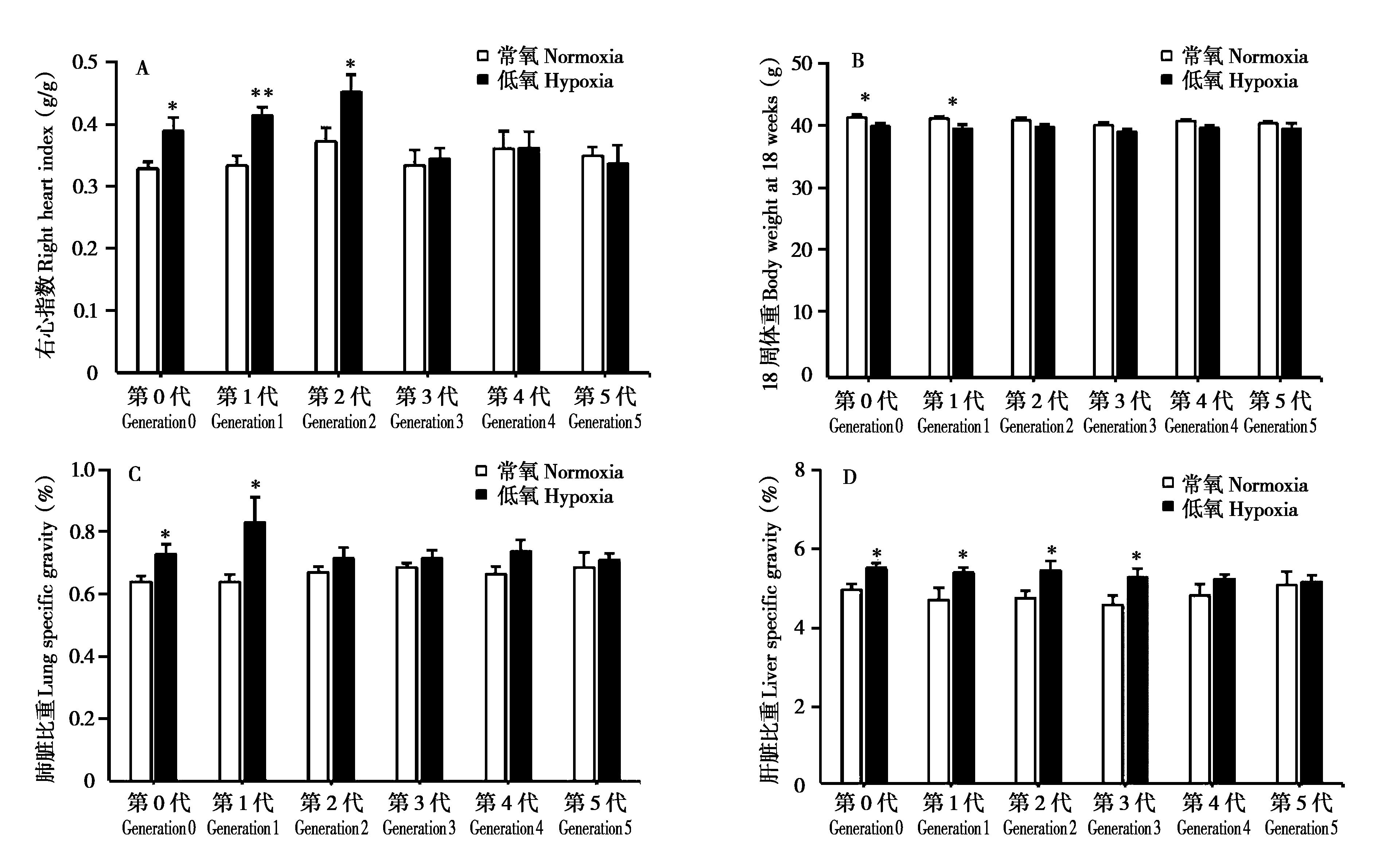
图1 高原低氧环境对小鼠体重及器官比重的影响. 右心指数 (A)、18周体重 (B)、肺脏比重 (C) 和肝脏比重 (D). n = 9. *P < 0.05,**P < 0.01
Fig.1 Effects of plateau hypoxic environment on body weight and organ proportion of mice. Right heart index (A), body weight at 18 weeks (B), lung specific gravity (C) and liver specific gravity (D). n = 9. *P < 0.05, **P < 0.01
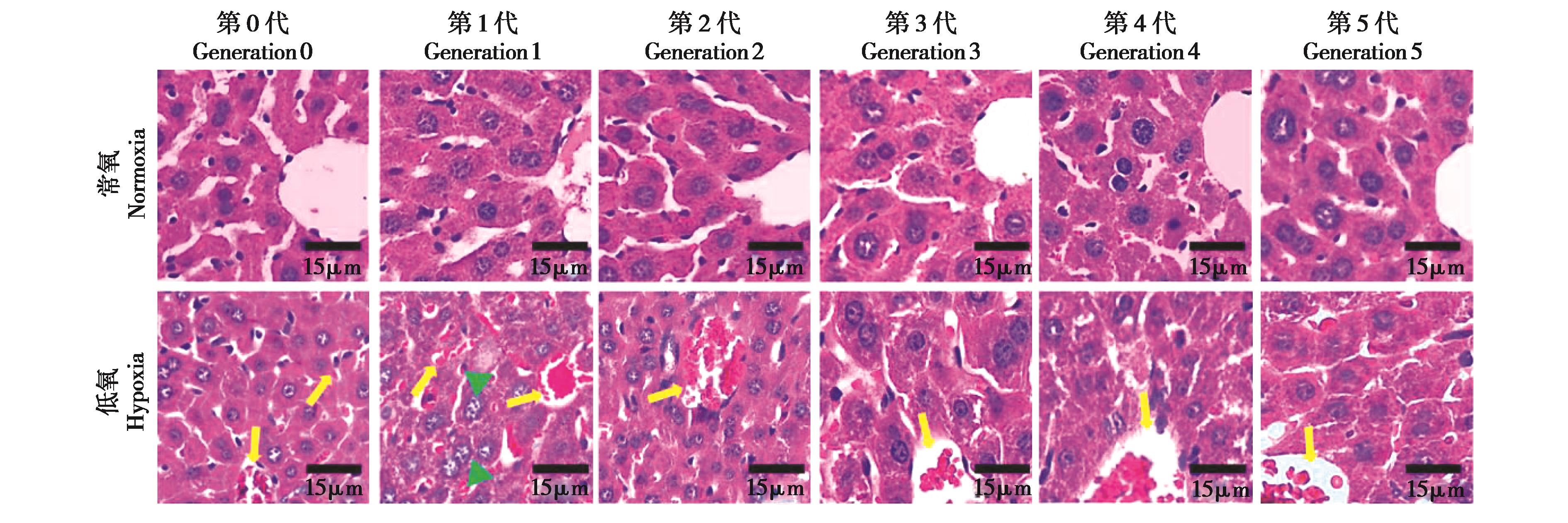
图2 高原低氧环境对小鼠肝脏组织形态的影响.常氧和低氧第0 ~ 5代肝脏HE染色代表性图. 标尺 = 15 μm.红细胞浸润 (黄色箭头),肝小叶内脂滴空泡 (绿色三角)
Fig.2 Effects of plateau hypoxic environment on liver tissue morphology of mice. Representative images of HE staining of normoxic and hypoxic livers from generation 0 to generation 5. Scale bars represent 15 μm.Red blood cell infiltration (yellow arrow), intralobular lipid vacuoles (green triangle)
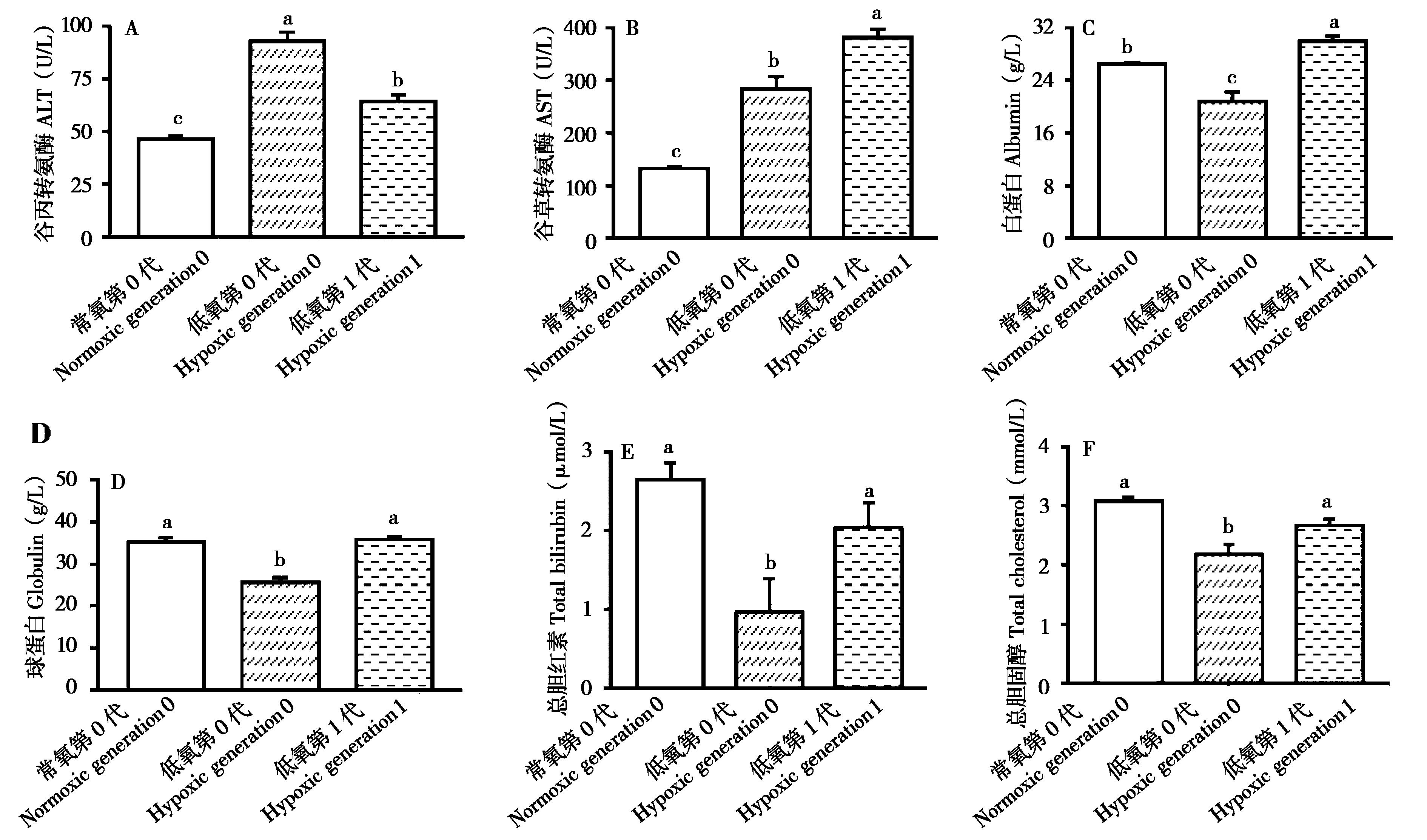
图3 高原低氧环境对小鼠血液生化指标的影响.谷丙转氨酶 (A),谷草转氨酶 (B),白蛋白 (C),球蛋白 (D),总胆红素 (E),总胆固醇 (F). n = 3.不同字母代表各组间有显著性差异 (P < 0.05)
Fig.3 Effects of plateau hypoxic environment on biochemical indexes of mice. Alanine aminotransferase (ALT) (A), aspartate aminotransferase (AST) (B), albumin (C), globulin (D), total bilirubin (E), total cholesterol (F). n = 3. Bars with different letters were significantly different (P < 0.05)

图4 高原低氧环境对小鼠血糖水平和胰岛素水平的影响. GTT血糖浓度 (A),GTT血清胰岛素水平 (B)和ITT血糖浓度 (C). n = 3.不同字母代表各组间有显著性差异 (P < 0.05)
Fig.4 Effects of plateau hypoxic environment on blood sugar and insulin levels of mice. GTT blood glucose concentration (A), GTT serum insulin level (B), ITT blood glucose concentration (C). n = 3.Bars with different letters were significantly different (P < 0.05)
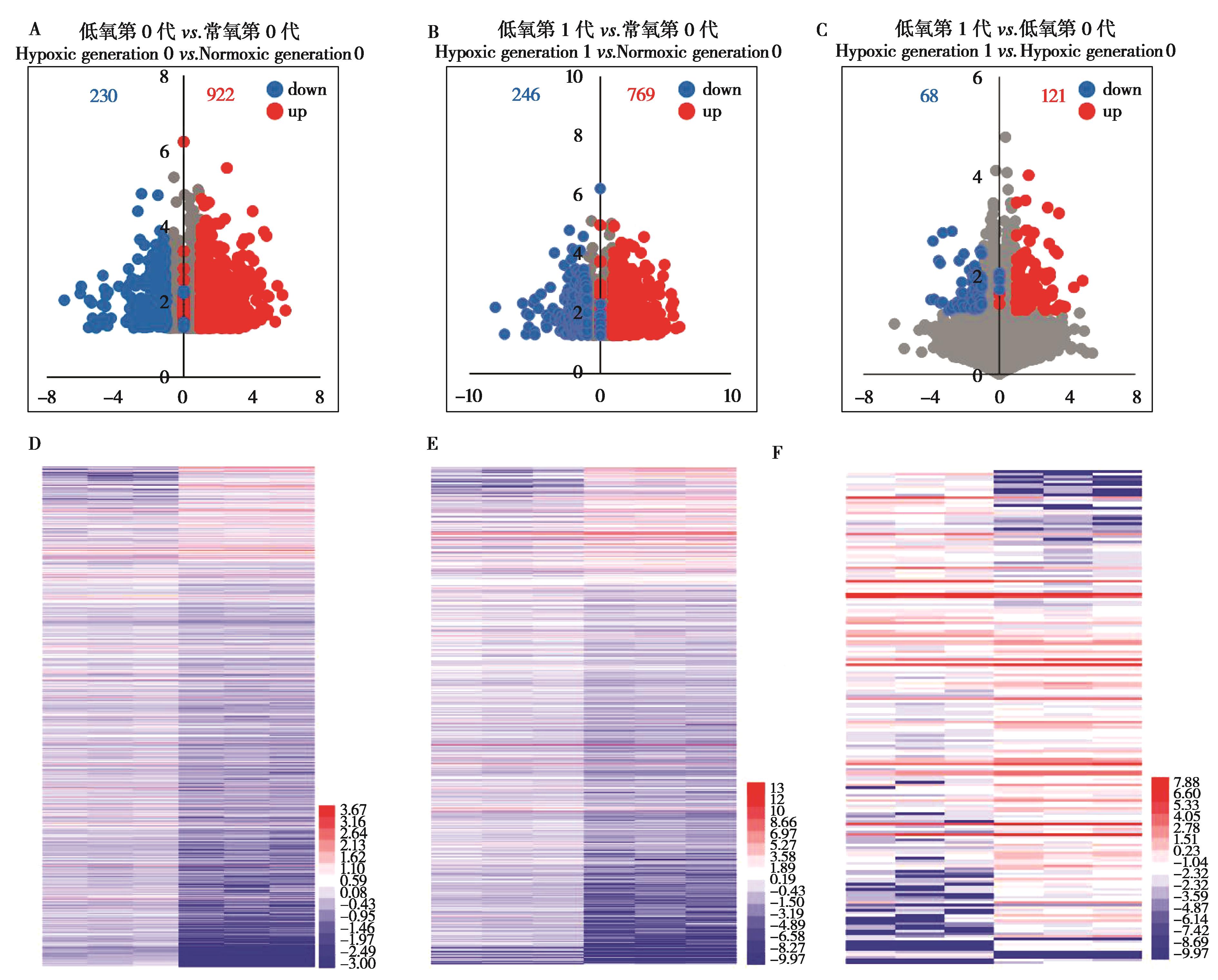
图5 低氧和常氧小鼠肝脏差异表达基因分析.低氧第0代 vs. 常氧第0代,低氧第1代 vs. 常氧第0代 和低氧第1代 vs. 低氧第0代差异表达基因数量 (A ~ C) 和热图 (D ~ E)
Fig.5 The differentially expressed gene analysis of mice liver in Hypoxic group and Normoxic group. Numbers of differentially expressed gene (A ? C) and Heatmap (D ? E) of Hypoxic generation 0 vs. Normoxic generation 0, Hypoxic generation 1 vs. Normoxic generation 0 and Hypoxic generation 1 vs. Hypoxic generation 0
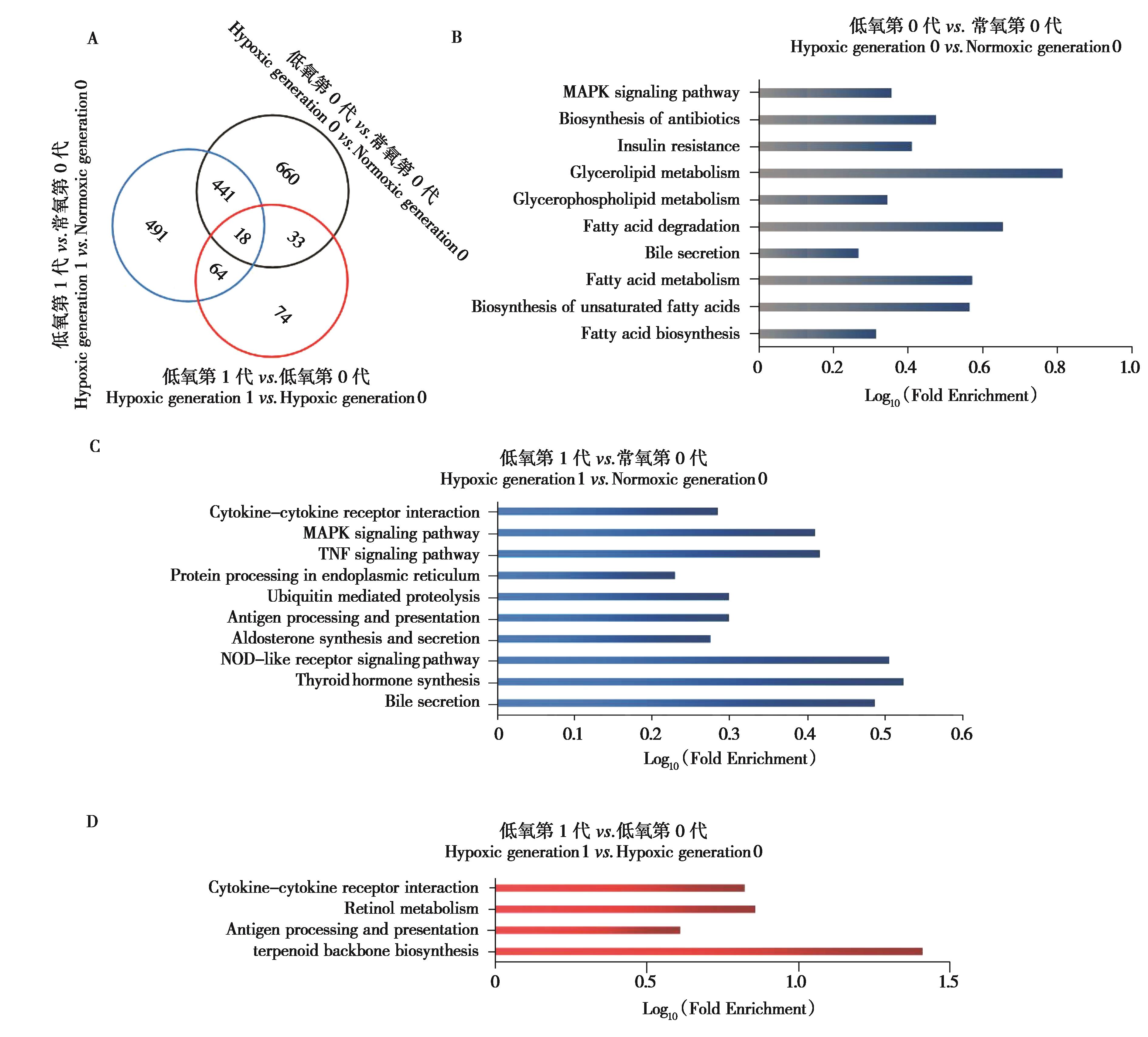
图6 低氧与常氧小鼠肝脏差异表达基因分析.低氧第0代 vs.常氧第0代,低氧第1代 vs.常氧第0代 和低氧第1代 vs.低氧第0代差异基因数量维恩图 (A) 和KEGG通路分析图 (B ~ D)
Fig.6 The differentially expressed gene analysis of mice liver in Hypoxic group and Normoxic group. The Venn diagram of differentially expressed gene (A) and KEGG pathway analysis diagram (B ? D) of Hypoxic generation 0 vs.Normoxic generation 0, Hypoxic generation 1 vs.Normoxic generation 0 and Hypoxic generation 1 vs.Hypoxic generation 0
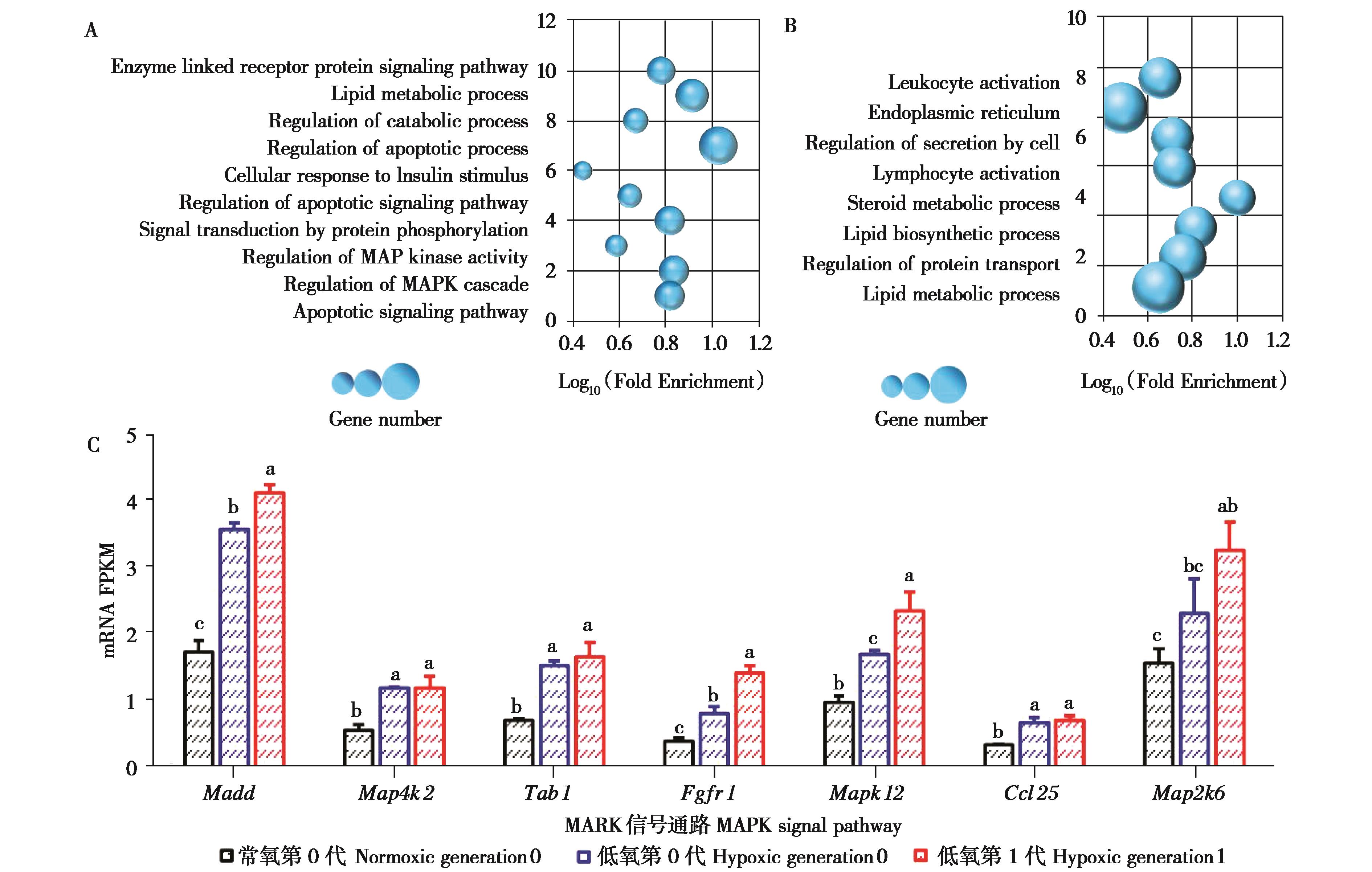
图7 低氧小鼠肝脏差异基因表达分析.低氧第0代与低氧第1代差异表达基因的GO分析 (A,B),MAPK信号通路相关基因的mRNA FPKM表达量 (C). 不同字母代表各组间有显著性差异 (P < 0.05)
Fig. 7 Effects of exposure to high altitude hypoxia on next generation liver. GO analysis of differentially expressed gene between Hypoxic generation 0 and Hypoxic generation 1 (A, B), mRNA FPKM expression level of genes related to MAPK signaling pathway (C). Bars with different letters were significantly different (P < 0.05)
| Bogdanova A, Petrushanko I Y, Hernansanz‑Agustín P, Martínez‑Ruiz A. 2016.‘Oxygen sensing’by Na, K-ATPase: these miraculous thiols. Frontiers in Physiology, 7: 314. | |
| Cargnello M, Roux P P. 2011. Activation and function of the mapks and their substrates, the mapk‑activated protein kinases. Microbiology and Molecular Biology Reviews, 75 (1): 50-83. | |
| Chen H J, Edwards R, Tucci S, Bu P, Milsom J, Lee S, Edelmann W, Gümüs Z H, Shen X, Lipkin S. 2012. Chemokine 25-induced signaling suppresses colon cancer invasion and metastasis. The Journal of Clinical Investigation, 122 (9): 3184-3196. | |
| Chen M X, Shen H, Zhu L L, Yang H F, Ye P, Liu P F, Gu Y, Chen S L. 2019. Berberine attenuates hypoxia-induced pulmonary arterial hypertension via bone morphogenetic protein and transforming growth factor-β signaling. Journal of Cellular Physiology, 234 (10): 17482-17493. | |
| Corless J K, Middleton H M. 1983. Normal liver function. A basis for understanding hepatic disease. Archives of Internal Medicine, 143 (12): 2291-2294. | |
| Cursio R, Miele C, Filippa N, Van Obberghen E, Gugenheim J. 2008. Liver HIF‑1 alpha induction precedes apoptosis following normothermic ischemia-reperfusion in rats. Transplantation Proceedings, 40 (6): 2042-2045. | |
| Henne M. 2019. And three’s a party: lysosomes, lipid droplets, and the ER in lipid trafficking and cell homeostasis. Current Opinion in Cell Biology, 59: 40-49. | |
| Hou Y P, Yang H A, Cui Z S, Tai X H, Chu Y L, Guo X. 2017. Tauroursodeoxycholic acid attenuates endoplasmic reticulum stress and protects the liver from chronic intermittent hypoxia induced injury. Experimental and Therapeutic Medicine, 14 (3): 2461-2468. | |
| Huang Y, Li X H, Wang Y R, Wang H, Huang C, Li J. 2014. Endoplasmic reticulum stress‑induced hepatic stellate cell apoptosis through calcium‑mediated JNK/P38 MAPK and Calpain/Caspase-12 pathways. Molecular and Cellular Biochemistry, 394 (1-2): 1-12. | |
| Huang Y, Wang D D, Wang X, Zhang Y J, Liu T, Chen Y T, Tang Y H, Wang T, Hu D, Huang C X. 2016. Abrogation of CC chemokine receptor 9 ameliorates ventricular remodeling in mice after myocardial infarction. Scientific Reports, 6: 32660. | |
| Hernández‑Bustabad A, Morales‑Arraez D, González‑Paredes F J, Abrante B, Diaz‑Flores F, Abreu‑Gonzalez P, de la Barreda R, Quintero E, Hernández‑Guerra M. 2022. Chronic intermittent hypoxia promotes early intrahepatic endothelial impairment in rats with non‑alcoholic fatty liver disease. American Journal of Physiology. Gastrointestinal and Liver Physiology.DOI: 10.1152/ajpgi.00300.2021 . | |
| Jin S, Chen Z, Lunan Y, Zeng Y, Wen T, Li B, Zhao J, Wang W, Xu M, Yang J. 2009. Can liver transplantation achieve similar effects at high altitudes compared with plains: case report. Transplantion Proceedings, 41 (5): 2003-2005. | |
| Ke Q, Costa M. 2006. Hypoxia-inducible factor-1 (HIF‑1). Molecular Pharmacology, 70 (5): 1469-1480. | |
| Kang H H, Kim I K, Lee H I, Joo H, Lim J U, Lee J, Lee S H, Moon H S. 2017. Chronic intermittent hypoxia induces liver fibrosis in mice with diet-induced obesity via TLR4/MyD88/MAPK/NF-kB signaling pathways. Biochemical and Biophysical Research Communications, 490 (2): 349-355. | |
| Lebeaupin C, Vallée D, Hazari Y, Hetz C, Chevet E, Bailly‑Maitre B. 2018. Endoplasmic reticulum stress signalling and the pathogenesis of non-alcoholic fatty liver disease. Journal of Hepatology, 69 (4): 927-947. | |
| Li W B, Jia Z P, Xie H, Zhang J H, WangY L, Hao Y, Wang R.2014. Effects of acute exposure to high altitude on hepatic function and CYP 1A2 and CYP 3A4 activities in rats. Journal of Southern Medical University, 34: 1203-1206. | |
| Liu F Y, Hu L, Li Y X, Liu S M, Tang Y P, Qi S G, Yang L, Wu T Y. 2015. Effect of altitude chronic hypoxia on liver enzymes and its correlation with ACE/ACE2 in yak and migrated cattle. Chinese Journal of Applied Physiology, 31 (3): 272. | |
| Lukas J, Pospech J, Oppermann C, et al. 2019. Role of endoplasmic reticulum stress and protein misfolding in disorders of the liver and pancreas. Advances in Medical Sciences, 64 (2): 315-323. | |
| Li S, Yang Q E. 2022. Hypobaric hypoxia exposure alters transcriptome in mouse testis and impairs spermatogenesis in offspring. Gene, 823: 146390. | |
| Madrigal‑Santillán E, Madrigal‑Bujaidar E, Álvarez‑González I, Sumaya‑Martínez M T, Gutiérrez‑Salinas J, Bautista M, Morales‑González Á, García‑Luna Y, González‑Rubio M, Aguilar‑Faisal J L, Morales‑González J A. 2014. Review of natural products with hepatoprotective effects. World Journal of Gastroenterology, 20 (40): 14787-14804. | |
| Mylonis I, Chachami G, Paraskeva E, Simos G. 2008. Atypical CRM1-dependent nuclear export signal mediates regulation of hypoxia-inducible factor-1alpha by MAPK. The Journal of Biological Chemistry, 283 (41): 27620-27627. | |
| Nath B, Szabo G. 2012. Hypoxia and hypoxia inducible factors: diverse roles in liver diseases. Hepatology, 55 (2): 622-633. | |
| Piret J P, Mottet D, Raes M, Michiels C. 2002. CoCl2, a chemical inducer of hypoxia-inducible factor-1, and hypoxia reduce apoptotic cell death in hepatoma cell line HepG2. Annals of the New York Academy of Sciences, 973 (1): 443-447. | |
| Patel J C, Khurana P, Sharma Y K, Kumar B, Ragumani S. 2018. Chronic lifestyle diseases display seasonal sensitive comorbid trend in human population evidence from Google Trends. PLoS ONE, 13 (12): e0207359. | |
| Reed W A, Manning R T, Hopkins L T.1964. Effects of hypoxia and hyperthermia on hepatic tissue of the dog. American Journal of Physiology, 206 (6): 1304. | |
| Rius B, Duran‑Güell M, Flores‑Costa R, López‑Vicario C, Lopategi A, Alcaraz‑Quiles J, Casulleras M, Lozano J J, Titos E, Clària J. 2017. The specialized proresolving lipid mediator maresin 1 protects hepatocytes from lipotoxic and hypoxia-induced endoplasmic reticulum stress. The Federation of American Societies for Experimental Biology, 31 (12): 5384-5398. | |
| Shingu K, Eger E I, Johnson B H. 1982. Hypoxia per se can produce hepatic damage without death in rats. Anesthesia and Analgesia, 61 (10): 820-823. | |
| Song M J, Malhi H. 2019.The unfolded protein response and hepatic lipid metabolism in non alcoholic fatty liver disease. Pharmacology & Therapeutics, 203: 107401. | |
| Tian Y M, Liu Y, Wang S, Dong Y, Su T, Ma H J, Zhang Y. 2016. Anti-diabetes effect of chronic intermittent hypobaric hypoxia through improving liver insulin resistance in diabetic rats. Life Sciences, 150: 1-7. | |
| Troeger J S, Schwabe R F. 2011. Hypoxia and hypoxia-inducible factor 1α: potential links between angiogenesis and fibrogenesis in hepatic stellate cells. Liver International: Official Journal of the International Association for the Study of the Liver, 31 (2): 143-145. | |
| Tao H P, Jia G X, Zhang X N, Wang Y J, Li B Y, Yang Q E. 2022. Paternal hypoxia exposure impairs fertilization process and preimplantation embryo development. Zygote, 30 (1): 48-56. | |
| Vicari A P, Figueroa D J, Hedrick J A, Foster J S, Singh K P, Menon S, Copeland N G, Gilbert D J, Jenkins N A, Bacon K B, Zlotnik A. 1997. TECK: a novel CC chemokine specifically expressed by thymic dendritic cells and potentially involved in T cell development. Immunity, 7 (2): 291-301. | |
| Wang Y Q, Huang Y M, Guan F, Xiao Y, Deng J, Chen H Y, Chen X L, Li J R, Huang H J, Shi C W. 2013. Hypoxia-inducible factor-1alpha and MAPK co‑regulate activation of hepatic stellate cells upon hypoxia stimulation. PLoS ONE, 8 (9): e74051. | |
| Watt M J, Miotto P M, De Nardo W, Montgomery M K. 2019. The liver as an endocrine organ‑linking NAFLD and insulin resistance. Endocrine Reviews, 40 (5): 1367-1393. | |
| Xiong Y L, Wang Y M, Xiong Y L, Gao W, Teng L H. 2020. Salidroside alleviated hypoxia-induced liver injury by inhibiting endoplasmic reticulum stress‑mediated apoptosis via IRE1α/JNK pathway. Biochemical and Biophysical Research Communications, 529 (2): 335-340. | |
| Yuen V W, Wong C C. 2020. Hypoxia-inducible factors and innate immunity in liver cancer. The Journal of Clinical Investigation, 130 (10): 5052-5062. | |
| Zaballos A, Gutiérrez J, Varona R, Ardavín C, Márquez G. 1999. Cutting edge: identification of the orphan chemokine receptor GPR- 9-6 asCCR9, the receptor for the chemokine TECK. Journal of immunology (Baltimore, Md.: 1950), 162 (10): 5671-5675. | |
| 冯恩志, 戴胜归, 杨生岳. 2014. 低氧性肺动脉高压研究进展. 中华肺部疾病杂志, 7 (3): 84-87. | |
| 杜继曾, 张家兴. 2004. 低氧下生长发育抑制与认知功能促进的调节机制.珠海: 中国生理学会第五届比较生理学学术会议, 16-17. | |
| 杜继曾, 李庆芬. 1982. 模拟高原低氧对高原鼠兔和大鼠器官与血液若干指标的影响. 兽类学报, 2 (1): 35-42. | |
| 李永慧, 李永芳, 杨梅. 2016. 唐古特青兰对高原低氧大鼠肝损伤的保护作用. 高原医学杂志, 26 (2): 6-9. | |
| 荣黎, 曾维政, 吴晓玲. 2009. 高原缺氧与肝脏损伤. 世界华人消化杂志, 8: 189-195. | |
| 程守科, 于军一, 司本辉, 肖庆林, 梁子钧. 2001. 高原低氧环境下红细胞增多和血液粘度间关系的研究. 中国应用生理学杂志, 17 (3): 231-235. | |
| 廖卫公, 高钰琪, 吴艺, 蔡明春, 范有明. 2006. 低氧对大鼠附睾功能的影响. 生殖医学杂志, 15 (4): 252-256. |
| [1] | 王德华, 王祖望. 青藏高原小型哺乳动物的生理生态学研究:从个体到生态系统[J]. 兽类学报, 2022, 42(5): 482-489. |
| [2] | 霍达亮, 廖莎莎, 曹静, 赵志军. 不同温度下黑线仓鼠应对食物短缺的能量学对策[J]. 兽类学报, 2022, 42(1): 58-68. |
| [3] | 王德华, 赵志军, 张学英, 张志强, 徐德立, 邢昕, 杨生妹, 王政昆, 高云芳, 杨明. 中国哺乳动物生理生态学研究进展与展望[J]. 兽类学报, 2021, 41(5): 537-555. |
| [4] | 陈思梦, 贾婷, 朱万龙, 王政昆. 冷驯化条件下中缅树鼩脂肪组织代谢产物的变化[J]. 兽类学报, 2021, 41(2): 193-201. |
| [5] | 王宇杰, 刘雨杭, 秦姣, 刘郁桐, 聂海燕, 刘全生. 不同剂量炔雌醚对小鼠器官鲜重、繁殖生理和肝肠CYP3A4酶含量的影响[J]. 兽类学报, 2021, 41(2): 202-213. |
| [6] | 余静欣 邓光敏 鲍雨帆 赵志军. 黑线仓鼠断乳后能量代谢和脂肪累积的适应性调节[J]. 兽类学报, 2020, 40(6): 595-605. |
| [7] | 田双杰 张学英 刘伟 王德华. 长爪沙鼠的贮食行为与其个性和代谢水平之间的关系[J]. 兽类学报, 2020, 40(4): 307-316. |
| [8] | 谭春桃 余义博 姜占萍 钟亮 张堰铭 曲家鹏. 不同海拔地区高原鼠兔探究性和静止代谢率的差异[J]. 兽类学报, 2020, 40(1): 27-36. |
| [9] | 尹飞 秦姣 陈毅 苏欠欠 雷 霆 张春兰 刘全生. 食物营养成分变化对卡氏小鼠和黄毛鼠摄食消化的影响[J]. 兽类学报, 2019, 39(6): 670-677. |
| [10] | 赵园春 张学英 王德华. 布氏田鼠哺乳期低温经历抑制成年期神经再生[J]. 兽类学报, 2019, 39(5): 485-495. |
| [11] | 崔志强 刘新宇 宋士一 杨明. 狭颅田鼠的代谢特征及体温调节[J]. 兽类学报, 2019, 39(3): 295-301. |
| [12] | 罗利娟 王胜男 杨明 刘全生. 小鼠小肠四种消化酶活力的胎后发育模式[J]. 兽类学报, 2018, 38(3): 286-294. |
| [13] | 闵红霞 毛思思 黄奕鑫 赵志军. 防御性攻击行为对黑线仓鼠能量收支的影响[J]. 兽类学报, 2018, 38(2): 166-173. |
| [14] | 施璐璐 谭松 闻靖 赵志军. 黑线仓鼠的BMR个体差异及其应对高脂食物的能量学对策[J]. 兽类学报, 2017, 37(2): 179-188. |
| [15] | 郭爱伟 党心言 陈粉粉 张颖俊 崔亮伟 肖文. 拉沙山黑白仰鼻猴食物中单宁含量的变化[J]. 兽类学报, 2016, 36(4): 388-396. |
| 阅读次数 | ||||||
|
全文 |
|
|||||
|
摘要 |
|
|||||
 青公网安备 63010402000199号 青ICP备05000010号-2
青公网安备 63010402000199号 青ICP备05000010号-2